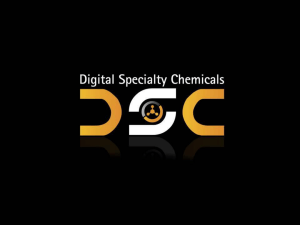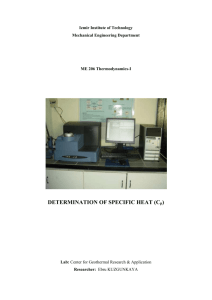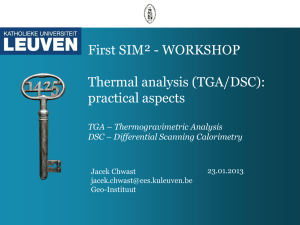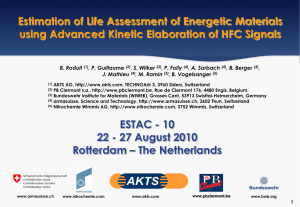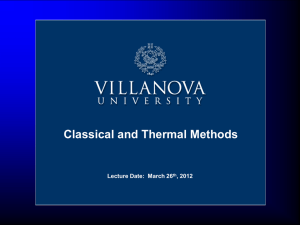Thermal Analysis - CMA - Trinity College Dublin
advertisement
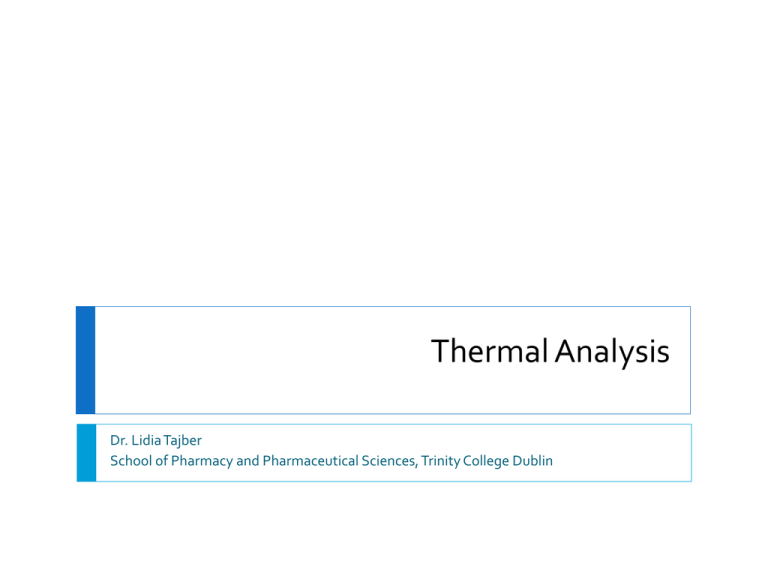
Thermal Analysis Dr. Lidia Tajber School of Pharmacy and Pharmaceutical Sciences, Trinity College Dublin Characterisation for Pharma Active pharmaceutical ingredients (API, drugs) Excipients (additives, fillers etc.) Organic, inorganic Not always single components Solids or liquids Not always pure Formulations (dosage forms, delivery systems) Organic molecules, peptides, proteins Single components Mainly solids (crystalline, amorphous or semi-crystalline) Pure molecules Mixtures of APIs and excipients Packaging materials Physical Forms of Solids Polymorphism - the ability of a compound to crystallise in more than one crystal form Pseudopolymorphic forms (solvated forms) - crystalline solids containing solvent molecules as an integral part of their crystal structure Amorphism - the absence of regular or crystalline structure in a body solid; amorphous materials do not possess three-dimensional long-range molecular order Different thermal behaviour Polymorph A Polymorph B Solvate A Solvate B Importance of Solid State Forms in Pharma Bioavailability (solubility/dissolution rate) Stability (physical and chemical) Processing factors Hygroscopicity Bulk and mechanical properties Ease of isolation, filtration and drying Degree of purity Thermal Analysis Techniques IUPAC definition - a group of techniques in which a physical property is measured as a function of temperature, while the sample is subjected to a controlled temperature programme (heating, cooling or isothermal). A range of techniques e.g.: Differential Thermal Analysis (DTA) – temperature Differential Scanning Calorimetry (DSC) – energy Thermogravimetric Analysis (TGA) – mass Thermomechanical Analysis (TMA) – dimensions Dielectric Analysis (DEA) – dielectric/electric properties Basic Principles of Thermal Analysis Modern instrumentation used for thermal analysis usually consists of the following parts: sample holder/compartment for the sample sensors to detect/measure a property of the sample and the temperature an enclosure within which the experimental parameters (temperature, speed, environment) may be controlled a computer to control data collection and processing temperature control (furnace) sample sensors PC Differential Scanning Calorimetry (DSC) Most popular thermal technique DSC measures the heat absorbed or liberated during the various transitions in the sample due to temperature treatment Differential: sample relative to reference Scanning: temperature is ramped Calorimeter: measures heat DSC measurements are both qualitative and quantitative and provide information about physical and chemical changes involving: Endothermic processes – sample absorbs energy Exothermic processes – sample releases energy Changes in heat capacity Principles of DSC Analysis Power Compensation DSC High resolution / high sensitivity research studies Absolute specific heat measurement Very sensitive to contamination of sample holders Heat Flux DSC Routine applications Near / at line testing in harsh environments Automated operation Cost-sensitive laboratories Summary of Pharmaceutically Relevant Information Derived from DSC Analysis Melting points – crystalline materials Desolvation – adsorbed and bound solvents Glass transitions – amorphous materials Heats of transitions – melting, crystallisation Purity determination – contamination, crystalline/amorphous phase quantification Polymorphic transitions – polymorphs and pseudopolymorphs Processing conditions – environmental factors Compatibility – interactions between components Decomposition kinetics – chemical and thermal stability Typical Features of a DSC Trace ^exo Exothermic upwards Endothermic downwards MELTING CRYSTALLISATION GLASS TRANSITION DESOLVATION H2O 20 mW DECOMPOSITION Y-axis – heat flow X-axis – temperature (and time) 40 60 80 100 120 140 160 180 200 220 240 260 280 300 o temperature [ C] Melting Point Onset = melting point (mp) ^exo MELTING 20 mW Heat of fusion (melting) = integration of peak 40 60 80 100 120 140 160 180 200 220 240 260 280 300 o temperature [ C] DSC scan of a crystalline material – one polymorphic form Polymorphic Forms ^exo TRANSITION STABLE FORM METASTABLE FORM 20 mW 40 60 80 100 120 140 160 180 200 220 240 260 280 300 o temperature [ C] DSC scan of a crystalline material – polymorphic transition Pseudopolymorphism ^exo MELTING DEHYDRATION 20 mW 40 60 80 100 120 140 160 180 200 220 240 260 280 300 o temperature [ C] DSC scan of a hydrate Amorphous Material DEHYDRATION Midpoint = glass transition (Tg) GLASS TRANSITION 1 mW 40 60 80 100 120 140 160 180 200 220 240 260 280 300 temperature [°C] Polyvinylpyrrolidone (PVP) co-processed with hydroflumethiazide Purity Determination Purity of phenacetin Source: TA Instruments, Cassel RB, Purity Determination and DSC Tzero™ Technology Compatibility Studies Source: Schmitt E et al. Thermochim Acta 2001, 380 , 175 – 183 Variants of DSC Conventional – linear temperature (cooling, heating) programme Fast scan DSC – very fast scan rates (also linear) MTDSC (modulated temperature DSC) – more complex temperature programmes, particularly useful in the investigation of glass transitions (amorphous materials) HPDSC (high pressure DSC) – stability of materials, oxidation processes Fast Scan DSC, Rapid Scanning DSC, (HyperDSCTM) This method provides the ability to perform valid heat flow measurements while heating or cooling a sample with fast linear controlled rates Benefits: HyperDSCTM - rates up to 500°C/min Other non-commercial systems - up to 100,000°C/min Increased sensitivity for detection of weak transitions Analysis of samples without inducing changes Small sampling requirements – a fraction of mg can be used Fast screening for high throughput requirements - a quick overview of new samples Disadvantages: Accuracy: transitions can be shifted by as much as 40oC Repeatabiliy: very sensitive to thermal lag and sample preparation Fast Scan DSC, Rapid Scanning DSC, (HyperDSCTM) Pharma applications: Enhanced analysis of polymorphism Detection of low level amorphous content Suppression of decomposition – “true” melting points Detection of low energy transitions Characterisation close to processing conditions Separation of overlapping events Modulated Temperature DSC (MTDSC) This technique uses composite heating profile: determines heat capacity and separates heat flow into the reversible and non-reversible components Benefits Increased sensitivity for detecting weak transitions – especially glass transition Separation of complex events into their: heat capacity (reversible) e.g. glass transition, melting and kinetic components (non-reversible) e.g. evaporation, crystallisation, decomposition Disadvantages Slow data collection Risk of sample transformation Variants of MTDSC Sinusoidal modulation (easy, only one frequency only) – TA Instruments Step scan modulation (easy, precise) – PerkinElmer TOPEM® modulation (stochastic modulation, complex calculations, but multiple frequency data) – Mettler Toledo Saw tooth modulation Rectangular modulation Example of a MTDSC Curve Polyethylene terephthalate (PET) Source: Craig DQM and Reading M Thermal analysis of pharmaceuticals Thermogravimetric Analysis (TGA) A technique measuring the variation in mass of a sample undergoing temperature scanning in a controlled atmosphere Thermobalance allows for monitoring sample weight as a function of temperature The sample hangs from the balance inside the furnace and the balance is thermally isolated from the furnace balance sample purge gas furnace Summary of Pharmaceutically Relevant Information Derived from TGA Analysis Desolvation – adsorbed and bound solvents, stoichiometry of hydrates and solvates Decomposition – chemical and thermal stability Compatibility – interactions between components Examples of TGA Curves 2 mg 0 20 40 60 80 100 120 140 160 180 200 220 240 260 280 300 320 o temperature [ C] TGA curves of crystalline and amorphous substance Lactose monohydrate ^exo 20 mW 0 20 2 mg 40 60 80 100 120 140 160 180 200 220 240 260 280 300 320 340 o temperature [ C] DSC and TGA scans of lactose monohydrate Hyphenated Thermal Equipment Thermal techniques alone are insufficient to prove the existence of polymorphs and solvates Other complementary techniques are used e.g. microscopy, diffraction and spectroscopy Simultaneous analysis Types: DSC-TGA DSC-XRD – DSC coupled with X-ray diffraction TGA-MS – TG system coupled with a mass spectrometer TGA-FTIR – TG system coupled with a Fourier Transform infrared spectrometer TGA -MS or -FTIR - evolved gas analysis (EGA) others
